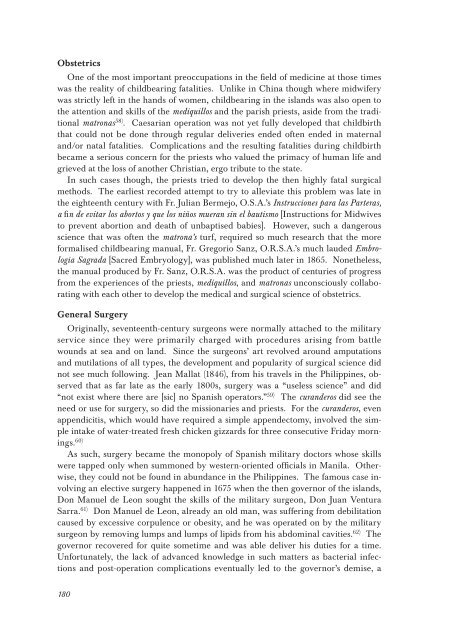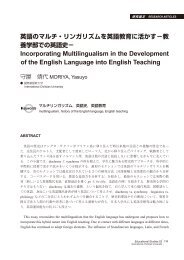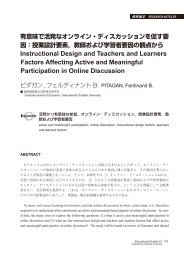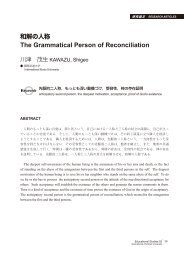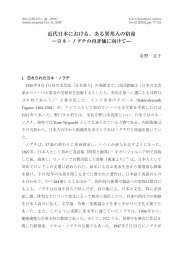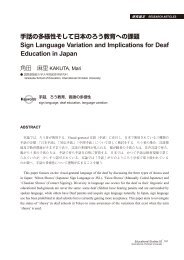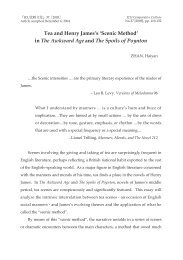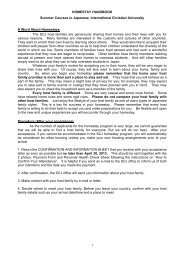Colonial Adaptations in Tropical Asia: Spanish Medicine ... - icu.ac.jp
Colonial Adaptations in Tropical Asia: Spanish Medicine ... - icu.ac.jp
Colonial Adaptations in Tropical Asia: Spanish Medicine ... - icu.ac.jp
Create successful ePaper yourself
Turn your PDF publications into a flip-book with our unique Google optimized e-Paper software.
Obstetrics<br />
One of the most important preoccupations <strong>in</strong> the field of medic<strong>in</strong>e at those times<br />
was the reality of childbear<strong>in</strong>g fatalities. Unlike <strong>in</strong> Ch<strong>in</strong>a though where midwifery<br />
was strictly left <strong>in</strong> the hands of women, childbear<strong>in</strong>g <strong>in</strong> the islands was also open to<br />
the attention and skills of the mediquillos and the parish priests, aside from the traditional<br />
matronas 58) . Caesarian operation was not yet fully developed that childbirth<br />
that could not be done through regular deliveries ended often ended <strong>in</strong> maternal<br />
and/or natal fatalities. Complications and the result<strong>in</strong>g fatalities dur<strong>in</strong>g childbirth<br />
became a serious concern for the priests who valued the primacy of human life and<br />
grieved at the loss of another Christian, ergo tribute to the state.<br />
In such cases though, the priests tried to develop the then highly fatal surgical<br />
methods. The earliest recorded attempt to try to alleviate this problem was late <strong>in</strong><br />
the eighteenth century with Fr. Julian Bermejo, O.S.A.’s Instrucciones para las Parteras,<br />
a f<strong>in</strong> de evitar los abortos y que los niños mueran s<strong>in</strong> el bautismo [Instructions for Midwives<br />
to prevent abortion and death of unbaptised babies]. However, such a dangerous<br />
science that was often the matrona’s turf, required so much research that the more<br />
formalised childbear<strong>in</strong>g manual, Fr. Gregorio Sanz, O.R.S.A.’s much lauded Embrologia<br />
Sagrada [Sacred Embryology], was published much later <strong>in</strong> 1865. Nonetheless,<br />
the manual produced by Fr. Sanz, O.R.S.A. was the product of centuries of progress<br />
from the experiences of the priests, mediquillos, and matronas unconsciously collaborat<strong>in</strong>g<br />
with each other to develop the medical and surgical science of obstetrics.<br />
General Surgery<br />
Orig<strong>in</strong>ally, seventeenth-century surgeons were normally attached to the military<br />
service s<strong>in</strong>ce they were primarily charged with procedures aris<strong>in</strong>g from battle<br />
wounds at sea and on land. S<strong>in</strong>ce the surgeons’ art revolved around amputations<br />
and mutilations of all types, the development and popularity of surgical science did<br />
not see much follow<strong>in</strong>g. Jean Mallat (1846), from his travels <strong>in</strong> the Philipp<strong>in</strong>es, observed<br />
that as far late as the early 1800s, surgery was a “useless science” and did<br />
“not exist where there are [sic] no <strong>Spanish</strong> operators.” 59) The curanderos did see the<br />
need or use for surgery, so did the missionaries and priests. For the curanderos, even<br />
appendicitis, which would have required a simple appendectomy, <strong>in</strong>volved the simple<br />
<strong>in</strong>take of water-treated fresh chicken gizzards for three consecutive Friday morn<strong>in</strong>gs.<br />
60)<br />
As such, surgery became the monopoly of <strong>Spanish</strong> military doctors whose skills<br />
were tapped only when summoned by western-oriented officials <strong>in</strong> Manila. Otherwise,<br />
they could not be found <strong>in</strong> abundance <strong>in</strong> the Philipp<strong>in</strong>es. The famous case <strong>in</strong>volv<strong>in</strong>g<br />
an elective surgery happened <strong>in</strong> 1675 when the then governor of the islands,<br />
Don Manuel de Leon sought the skills of the military surgeon, Don Juan Ventura<br />
Sarra. 61) Don Manuel de Leon, already an old man, was suffer<strong>in</strong>g from debilitation<br />
caused by excessive corpulence or obesity, and he was operated on by the military<br />
surgeon by remov<strong>in</strong>g lumps and lumps of lipids from his abdom<strong>in</strong>al cavities. 62) The<br />
governor recovered for quite sometime and was able deliver his duties for a time.<br />
Unfortunately, the lack of advanced knowledge <strong>in</strong> such matters as bacterial <strong>in</strong>fections<br />
and post-operation complications eventually led to the governor’s demise, a<br />
180


